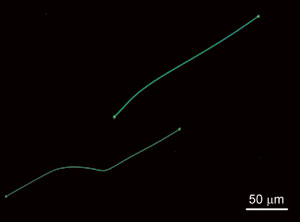
Organic Dye Molecules Form Waveguides
Daniel S. Burgess
Scientists at Japan’s National Institute for Materials Science in Tsukuba have reported the synthesis of single-mode waveguides by the self-assembly of organic dye molecules in solution. Waveguides produced from a thiacyanine dye transmit 520- to 560-nm light over distances of 250 μm without loss, suggesting that the approach may play a role in the development of miniaturized optoelectronic circuits.

Self-assembled single-mode waveguides produced from a thiacyanine dye transmit 520- to 560-nm light over distances of 250 μm without loss. Courtesy of Ken Takazawa.
Ken Takazawa, a senior researcher at the institute’s Tsukuba Magnet Laboratory, cited several other advantages of the structures for such nanoscale systems. First, being composed of organic materials, the waveguides should offer designers the flexibility to introduce substituents to control their shape, size, transmission characteristics and waveguiding efficiency. Second, the waveguides efficiently propagate light even when they are bent tightly. Third, their synthesis requires no special or complex processes — only a beaker and a hot plate, he noted.
Specifically, the investigators produced the waveguides in their demonstration by cooling a 0.2-mM aqueous solution of the thiacyanine dye molecules from 60 °C to room temperature. As the solution cools, the molecules combine into fibrous strands with a rectangular cross section. The cooling rate determines the width and height of the waveguides, and the duration of cooling determines their length.
The researchers attribute the waveguiding behavior of the structures to the fact that the molecules form H-aggregates. Takazawa explained that the absorption and emission bands of this type of aggregate generally are isolated, so the photoluminescence, generated as light is coupled into the structure, is not reabsorbed by the molecules and thus propagates through it.
A hurdle to the waveguides’ use in the development of microscale optoelectronic circuits involves their manipulation. “The waveguides are formed in a solution,” Takazawa said. “We need to place them at a desired position and connect them to other devices.”
The researchers plan to investigate means of manipulating and assembling the structures as desired. They also will examine structures grown using various thiacyanine derivatives to identify those with properties that are best suited to optoelectronic applications.
Nano Letters, July 2005, pp. 1293-1296.
Published: September 2005